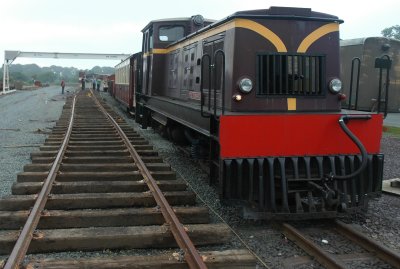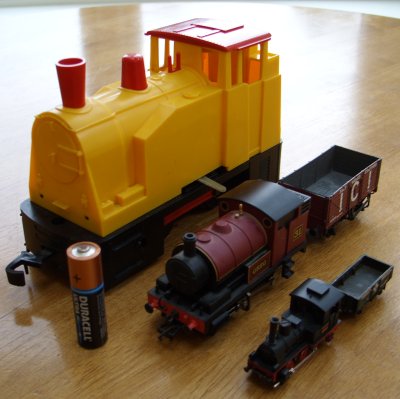Scale and Gauge
What does Gauge mean?
"Gauge" is all about the distance between the rails. In real, full-size railways, there's a measurement known as "Standard Gauge", which is the standard distance between the rails. Almost all the railways in the country are built to "Standard Gauge", which means that the trains can run on all the railways. There are exceptions to the standard. Where a railway is build with the rails closer together than normal, the term "narrow gauge" is used, and where the rails are futher apart, the term "broad gauge" is used.

Standard gauge track (4' 8¼") and 2 foot narrow
gauge
track (under the loco) on the WHR at Dinas
© Andy Rutter.
Back in the 19th Century when they were building the railways in Britain, most railways were build to a standard gauge of 4' 8¼". However, one brilliant engineer, who was building the line west out of London Paddington, towards Bristol, a chap by the name of Brunel, decided that his trains would be far more stable if he used a much greater distance between the wheels, and he adopted a gauge of 7' 8¼" (7 feet plus the width of his thumb, apparently) and this was called "Broad Gauge".
Now obviously, broad gauge trains couldn't run on standard gauge tracks, nor vice versa, so there were complicated arrangements where the parcels and people would be transferred from one train to another at the places where two railways came together, and there were some extremely complicated bits of trackwork where both gauges ran along the same bit of land.
In the end, in a Victorian "VHS versus Betamax" sort of battle [1], it was decided that the more prevalent technology would be used instead of the technologically superior one, and the Great Western Railway had to re-gauge itself to the standard. In a knee-jerk reaction typical of politicians of all eras, it became illegal to build or operate a railway unless it was Standard Gauge.
Where this fits into our story is that, at the time when non-standard gauges were politically incorrect, there were some situations where it wasn't economically sound to build a standard gauge railway, and a railway built to narrower dimensions, and designed for lighter trains would have been more appropriate. Any British railway where the rails were less than 4' 8¼" is classified as "narrow gauge", and there are examples of 3' gauge, 2' gauge and there were even some 18" gauge railways.
To confuse things even more, some countries adopted a different standard gauge from that in Britain, so one country's standard gauge could be another country's broad gauge. Russia, for example, has adopted a standard gauge of 5ft.
Also, there isn't a standard for narrow gauge. Even among the "little trains" of Wales, most of which are nominally 2 foot gauge, there are discrepancies of a few inches, meaning that interoperability is not possible, and visiting locomotives sometimes need to have their wheels reset, even if only by a quarter of an inch!
So, to recap, "Gauge" refers to the distance between the tracks. The standard gauge in the UK is 4' 8¼". Anything wider is "Broad Gauge". Anything narrower is "Narrow Gauge".
And what does Scale mean?
Scale is a term to describe how big a model of something is, for example, a half-scale model is a model which is half the size of the real thing. Scale is measured in a number of ways.
Some modelling scales use a ratio. For example, a OO trainset is about 1:76 scale, meaning that one cm on the model equates to 76cm on the real thing. The real thing is about 76 times the size (in linear measurements) of the model. A model of a 6' adult in OO would be about 2.5cm high.
Other modelling scales use a comparison, for example "4mm/ft". This tells you that 4mm on the model equates to one foot on the real thing. If you work it out, you'll find that 4mm/ft is 1:76.2.
Popular indoor model railways might be one of the following scales.
| Name | Approx Scales | |
|---|---|---|
| O | 1:32 | 7mm/ft |
| OO | 1:76.2 | 4mm/ft |
| N | 1:148 | 2mm/ft |
These modelling scales are typically used to model standard gauge trains. As such, the rails are 9mm apart for N gauge (hence 'N'), about 18mm apart for OO, and 32mm apart for O Gauge.

Model trains in O scale, OO scale and N scale respectively,
each representing a loco of approximately the same size in real life.
© Andy Watkins.
There are, of course loads of other scales which people model in, some smaller than N gauge -- for people with no space at all! -- and some larger, which tend to be used outdoors where there's more space. Some people are lucky enough (or rich enough) to have train sets in their garden which they can ride on, or in, or inside, depending on how big they are, all the way up to full size private railways in some cases.
So what's SM32?
OK, this is where it gets a little bit complicated. Modelling in "SM32" generally, means modelling 2ft Narrow Gauge in a scale of 16mm/ft. If you work it out, that means the track is 32mm apart to model 2ft gauge. The "SM" bit refers to 16mm" and the "32" bit refers to 32mm gauge. Got that?
The reason for modelling 2ft Narrow Gauge is that a lot of narrow gauge railways are about that gauge. The models are standardised at a particular gauge, even though the prototypes are all slightly different (for example, narrow gauge lines in Wales vary between 1'11½" and 2'6")
And what's G Scale?
Here things get even more interesting, because the 'G' refers to a Gauge, and not a scale, which is very naughty of the Garden Railway community, isn't it, calling a Gauge a Scale! The G actually stands for "groß" (gross, the German for "big") but is often believed to mean "Garden". "G scale" basically means a railway where the tracks are 45mm apart, and you can have whatever scale you like (and you can have it indoors if you wish, too).
Some commercial scales modelled on 45mm ('G') Gauge track are:
| SCALE | GAUGE MODELLED | MANUFACTURER |
|---|---|---|
| 1:19 | 2'9" | Accucraft live steam |
| 1:20.3 | 3ft gauge | Accucraft, Bachmann |
| 1:22.5 | 3'3" | LGB |
| 1:24 | 3'6" | Aristocraft |
| 1:29 | 4'3" ??? | Aristocraft live steam |
| 1:32 | Std Gauge | GAUGE ONE (AKA 3/8" scale) |
on 45mm gauge track, you can have 3ft narrow gauge in approximately 16mm/ft, or you can model standard gauge (it's called "Gauge 1" )
Footnote[1] for those of you too young to remember the VHS versus Betamax battle, it was similar to the Blu-Ray vs HD-DVD thing.